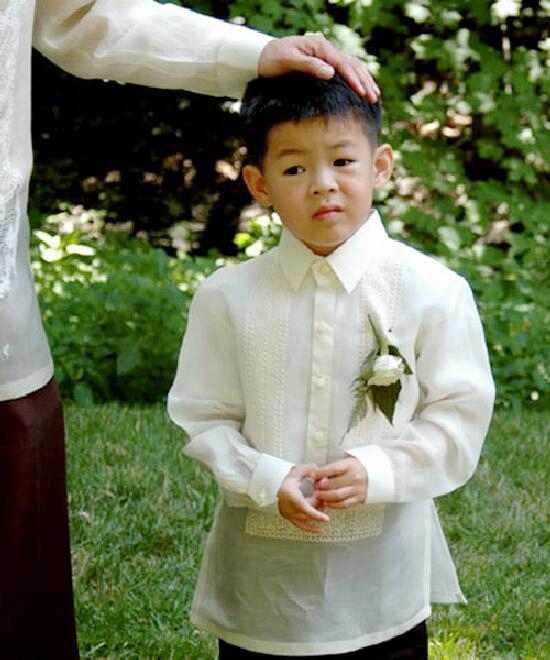
Figure 1.--Here a Filipino boy wears the Barong Tagalog in a formal Catholic wedding. |

|
The indigenous Filipinos were mostly Animists. Trade contacts brought Islsm to the southern Islands and there were some Chinese influences, both Budhism and Taoism. The Spanish first reached the Philippines under Magellan who was killed there (1521). The islands were named Spain's aggressively Catholic monarch, Phillip II. Spanish rule was over the following century gradually spread over the Philippines and a major aspect of Spanish rule was saving souls. Spain proceeded to colonize and Christianize most of the various islands. Thus both Christianity and Islam were superimposed on the animism of tribal communities. The Spanish political control and military force proved to be the deciding factor in making the Philippines a largely Catholic country. The Muslims inhabitants in the south, especially Mindanao, resisted Christianity. The Spanish faced insurgent efforts throughout the colonial period, but Christianity was widely accepted and is today the principal religion, mostlt Roman Catholics. Many Filipino children do a First Communion. The Philippines is thus the only Christian country in Asia. An estimated 90 percent of the population are Christians. Other religions include: Muslims (5 percent), Buddhists, Daoists, animism, and other religions. Buddhists and Taoists are mostly part of the Chinese ethnic community, although even the Chinese are mostly Catholic. Although small in number, the Daoists have built a spectacular temple on the outskirts of Cebu. Muslims remain less integrated than other religious minorities into Philippine culture and society, presumably because of the Western and secular nature of the wider Philippines society. Today there is some support for independence among Muslims in the south.
The indigenous Filipinos were mostly Animists. Trade contacts brought Islsm to the southern Islands and there were some Chinese influences, both Budhism and Taoism. The Spanish first reached the Philippines under Magellan who was killed there (1521). The islands were named Spain's aggressively Catholic monarch, Phillip II. Spanish rule was over the following century gradually spread over the Philippines and a major aspect of Spanish rule was saving souls. Spain proceeded to colonize and Christianize most of the various islands. Thus both Christianity and Islam were superimposed on the animism of tribal communities. The Spanish political control and military force proved to be the deciding factor in making the Philippines a largely Catholic country. The Muslims inhabitants in the south, especially Mindanao, resisted Christianity.
The Spanish faced insurgent efforts throughout the colonial period, but Christianity was widely accepted and is today the principal Filipino religion, mostly Roman Catholics. The Philippines is thus the only Christian country in Asia. An estimsated 90 percent of the population are Christians. Other religions include: Muslims (5 percent), Buddhists, Daoists, animism, and other religions. Buddhists and Taoists are mostly part of the Chinese ethnic community, although even the Chinese are mostly Catholic.
The Spanish faced insurgent efforts throughout the colonial period, but Christianity was widely accepted and is today the principal religion, mostly Roman Catholics. The Philippines is thus the only Christian country in Asia. An estimated 90 percent of the population are Christians. Other religions include: Muslims (5 percent), Buddhists, Daoists, animism, and other religions. Buddhists and Taoists are mostly part of the Chinese ethnic community, although even the Chinese are mostly Catholic. Many Filipino children do a First Communion.
Muslims remain less integrated than other religious minorities into Philippine culture and society, presumably because of the Western and secular nature of the wider Philippines society. Today there is some support for independence among Muslims in the south and a lingering insurgency.
Although small in number, the Daoists have built a spectacular temple on the outskirts of Cebu.
Animist was the principal religion of most Filipinos at the time the Spanish arrived. Indigenous Filipinos thought that all objects had souls or spirits. Nature was populated by these spirits. Even objects thatvappeared non-living, like rivers, mountains, rocks, and much more. This included natural phenomena such as fire, thunder, wind, cyclones were all believed to imbued with specific souls or even controlled by gods. While the Philippines was largely Chritianized by the Spanish, some Filipinos resisted the Spanish. A wide range of tribal groups in mounanenous areas of Luzon and the many islands that make up the Philippines. The tribal groups that resisted the Spanish, resisted Spanish culture including religion. This was the state of affairs when the Ameicans arrived in the Philippines. Force was not use by the Americans to pomote Catholocism or any other country. Misionary activity, however, increased and not just Catholic groups although they continued to be active. A good example is the Scheut mission at Patikian in the mountains of northern Luzon.
Navigate the Boys' Historical Clothing Web Site:
[Return to the Main Philippines page]
[Return to the Main Oceania page]
[Return to the Main countries page]
[Introduction]
[Activities]
[Biographies]
[Chronology]
[Cloth and textiles]
[Clothing styles]
[Countries]
[Topics]
[Bibliographies]
[Contributions]
[FAQs]
[Glossaries]
[Images]
[Links]
[Registration]
[Tools]
[Boys' Clothing Home]
